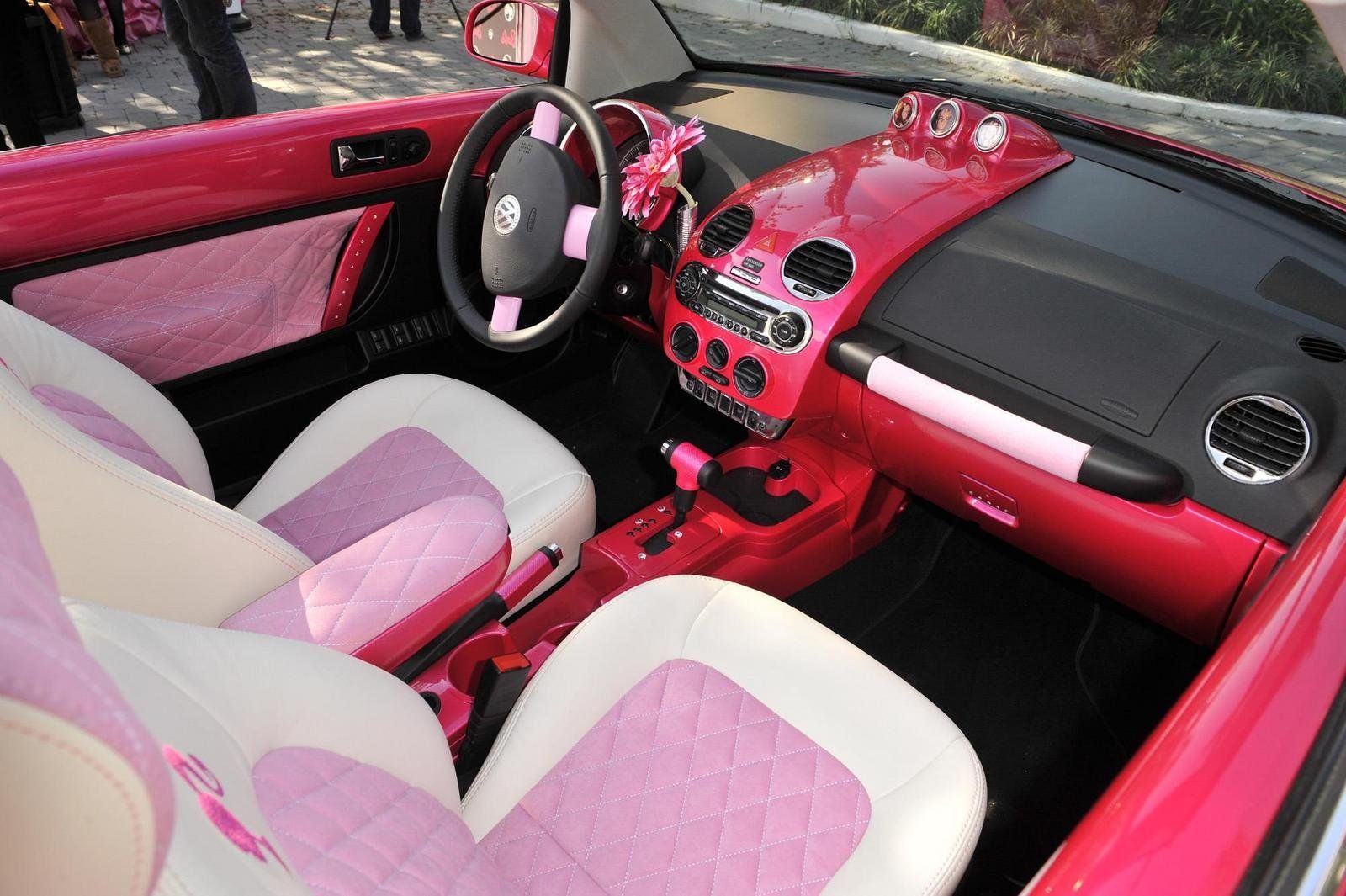
The Volkswagen Type 1, widely known as the Volkswagen Beetle, is an economy car produced by the German auto maker Volkswagen (VW) from 1938 until 2003. With over 21 million manufactured in an air-cooled, rear-engined, rear-wheel drive configuration, the Beetle is the longest-running and most-manufactured automobile of a single design platform anywhere in the world.

Volkswagen Beetle Interior

The Beetle is widely used in drag racing; its rearward (RR layout) weight distribution keeps the weight over the rear wheels, maximizing grip off the starting line. The car's weight is reduced for a full competition drag Beetle, further improving the grip and also the power to weight ratio. Combined with the Beetle's RR layout, wheelies can be achieved easily, but time "in the air" worsens 1/4 mile time. To prevent this, "wheelie bars" are added. The fastest time a beetle has run in the quarter mile was 7.78 in 2008.

Elegant Pink Volkswagen Beetle

Customized Beetle styles include the Rat rod and Cal Look which evolved during its lifespan. Customisation includes lowering the car's suspension, altering the wheels, removing or replacing the bumpers, as with pushbar. The stock bumpers are usually chromed or polished, sometimes painted or powder coated. Clubs dedicated to 'Cal Look' occur worldwide.Customizing may also include smoothing or shaving the body — removing trim and other parts, including door handles, badges and driprails, Frenching or tunnelling the headlights, lowering, custom hood and trunk hinging, chopping and lowering of the roof and replacing taillights and front indicators with smaller, simpler units.

Volkswagen Classic Beetle

Its engine, transmission, and cylinder heads were constructed of light alloy. An engine oil cooler (located in the engine fan's shroud) ensured optimal engine operating temperature and long engine life, optimized by a thermostat that bypassed the oil cooler when the engine was cold. Later models of the carburetor featured an automatic choke. Engine intake air passed through a metallic filter, while heavier particles were captured by an oil bath. After 1960, steering featured a hydraulic damper that absorbed steering irregularities.
 The Volkswagen Type 1, widely known as the Volkswagen Beetle, is an economy car produced by the German auto maker Volkswagen (VW) from 1938 until 2003. With over 21 million manufactured in an air-cooled, rear-engined, rear-wheel drive configuration, the Beetle is the longest-running and most-manufactured automobile of a single design platform anywhere in the world.
The Volkswagen Type 1, widely known as the Volkswagen Beetle, is an economy car produced by the German auto maker Volkswagen (VW) from 1938 until 2003. With over 21 million manufactured in an air-cooled, rear-engined, rear-wheel drive configuration, the Beetle is the longest-running and most-manufactured automobile of a single design platform anywhere in the world. The Beetle is widely used in drag racing; its rearward (RR layout) weight distribution keeps the weight over the rear wheels, maximizing grip off the starting line. The car's weight is reduced for a full competition drag Beetle, further improving the grip and also the power to weight ratio. Combined with the Beetle's RR layout, wheelies can be achieved easily, but time "in the air" worsens 1/4 mile time. To prevent this, "wheelie bars" are added. The fastest time a beetle has run in the quarter mile was 7.78 in 2008.
The Beetle is widely used in drag racing; its rearward (RR layout) weight distribution keeps the weight over the rear wheels, maximizing grip off the starting line. The car's weight is reduced for a full competition drag Beetle, further improving the grip and also the power to weight ratio. Combined with the Beetle's RR layout, wheelies can be achieved easily, but time "in the air" worsens 1/4 mile time. To prevent this, "wheelie bars" are added. The fastest time a beetle has run in the quarter mile was 7.78 in 2008. Customized Beetle styles include the Rat rod and Cal Look which evolved during its lifespan. Customisation includes lowering the car's suspension, altering the wheels, removing or replacing the bumpers, as with pushbar. The stock bumpers are usually chromed or polished, sometimes painted or powder coated. Clubs dedicated to 'Cal Look' occur worldwide.Customizing may also include smoothing or shaving the body — removing trim and other parts, including door handles, badges and driprails, Frenching or tunnelling the headlights, lowering, custom hood and trunk hinging, chopping and lowering of the roof and replacing taillights and front indicators with smaller, simpler units.
Customized Beetle styles include the Rat rod and Cal Look which evolved during its lifespan. Customisation includes lowering the car's suspension, altering the wheels, removing or replacing the bumpers, as with pushbar. The stock bumpers are usually chromed or polished, sometimes painted or powder coated. Clubs dedicated to 'Cal Look' occur worldwide.Customizing may also include smoothing or shaving the body — removing trim and other parts, including door handles, badges and driprails, Frenching or tunnelling the headlights, lowering, custom hood and trunk hinging, chopping and lowering of the roof and replacing taillights and front indicators with smaller, simpler units. Its engine, transmission, and cylinder heads were constructed of light alloy. An engine oil cooler (located in the engine fan's shroud) ensured optimal engine operating temperature and long engine life, optimized by a thermostat that bypassed the oil cooler when the engine was cold. Later models of the carburetor featured an automatic choke. Engine intake air passed through a metallic filter, while heavier particles were captured by an oil bath. After 1960, steering featured a hydraulic damper that absorbed steering irregularities.
Its engine, transmission, and cylinder heads were constructed of light alloy. An engine oil cooler (located in the engine fan's shroud) ensured optimal engine operating temperature and long engine life, optimized by a thermostat that bypassed the oil cooler when the engine was cold. Later models of the carburetor featured an automatic choke. Engine intake air passed through a metallic filter, while heavier particles were captured by an oil bath. After 1960, steering featured a hydraulic damper that absorbed steering irregularities.



No comments:
Post a Comment